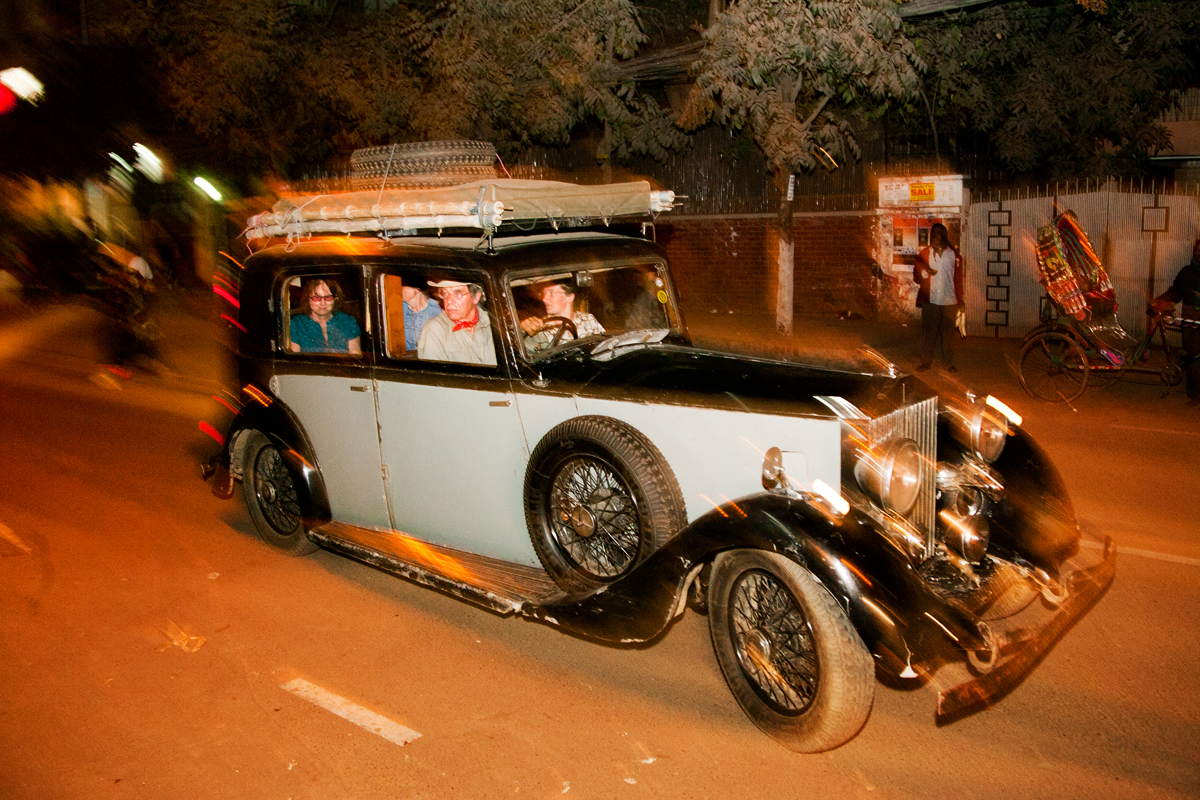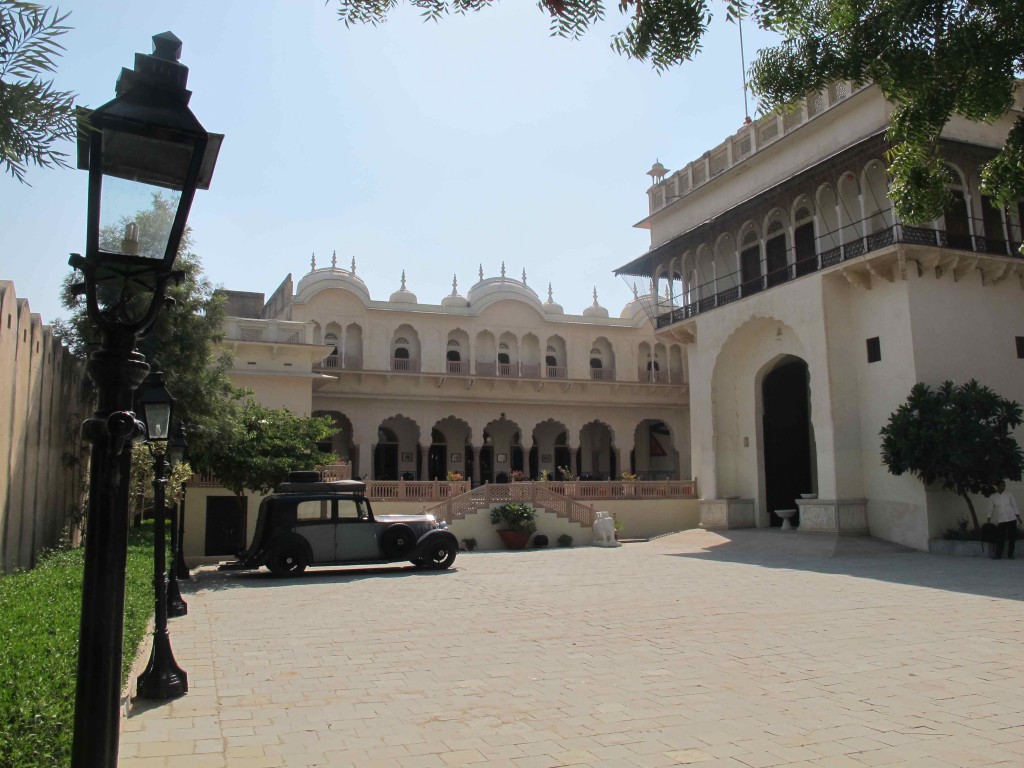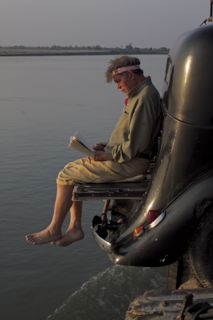Complete article with more photographs at Le Journal De La Photographie
 Chobi Mela VII Preparation ? Ranak Martin
Chobi Mela VII Preparation ? Ranak Martin
Festival Director Shahidul Alam talks about the challenges and expectations one faces when running a festival such as Chobi Mela and points out the festival?s uniqueness and beauty.
There?s only few days left before the beginning of Chobi Mela VII and there are still a thousand things to be done and we are awaiting many guests from all over the world. So tell me, how is this Chobi Mela different from previous editions of the festival? What is special this time round?
S. Alam : ?Firstly, it?s actually an extension of previous ones, What we?ve always done in Chobi Mela is to ensure that it?s a very inclusive festival, there are people from all the continents, there is a very diverse range of work in terms of photographic practices, but also in terms of the ideas behind it. Of course we have some artists who are here for very first time, I mean Graciela Iturbide will be here for the first time, Max Pam will be here for the first time, we are not sure yet if Eugene Richards is able to make it, they have very tight schedules but their work is already here. So yes! Very exciting work. Continue reading “Munem Wasif interviews Shahidul Alam on Chobi Mela VII”
Tag: Festival
Chobi Mela VII: A festival to savour
FESTIVAL
Dhaka 2013:?Chobi Mela VII
 Morning mist in Mohakhali during the recent cold spell in Dhaka ? Shahidul Alam/Drik/Majority World
Morning mist in Mohakhali during the recent cold spell in Dhaka ? Shahidul Alam/Drik/Majority World
The shutter speed of 125th of a second reserved for momentous slices of time, never slows down enough to listen to the sighs of the silent. Photography therefore is a selective witness. The history it records, a filtered history. It is a filtration different from the dominant narrative of the victor that history has been guilty of. This is more insidious, as it seeps into the very core of our consciousness. I smile for my grandma?s camera. The photojournalist waits for my tear to drop. The moments in between go unrecorded. A staccato history of grand gestures and seminal moments fails to record the nuanced lives we all live.
The medium has been digital all along. The black and whites of photography have largely failed to register the grey ambiguities of the human panorama, the binary perceptions that shape photographic vision failing to respond to subtlety. The everydayness of our lives with its tapestry of emotions, too plain to register amongst the dramatic peaks and troughs that photography has been measured by.
It is only through fissure that?fragility?has registered. It is only on being trampled that the delicate has been lamented. The staunch pillars of photography have rarely let light through the cracks. The frailty of a lost thought, the uncertainty of the first touch, are the insignificants that a camera passes by. The fragility of a tortured earth, the slow death of a glacier, the disappearance of the honeybee, too slow a change to register in 125th of a second.
In a gendered world fragility is not macho enough. In a misogynist industry, to pause is to be effeminate. Where sex and violence are the opiates we are fed on, quieter moments do not even make the ?B roll?. A sob too insignificant, to register on a megapixel sensor.
We look for those fleeting moments. A gossamer of gentle thoughts billowing in turbulent winds. An unraveling strand of humanity bending against the onslaught of invasive culture. The frail existence of a marginal farmer eking out a living in the shadows of engineered genes. Communities holding out against the rising tide of modernity. Lost languages, vanishing cultures, disappearing forests, all entwined by a vulnerability, familiar to those who resist market forces.
In an economy gasping for breath, in an ecosystem reeling under consumption, waste and the ravages of war, the greed of a few threaten the future of many. We challenge you to push back the tide of unbridled growth and lay your stake to a sustainable universe. It is only by embracing the fragility of this world that we will make it your own.
Shahidul Alam, Festival Director
Chobi Mela – International Festival of Photography
January 25 to February 7, 2013
House 58, Road 15A (New),
Dhanmondi, Dhaka 1209
Bangladesh
Chobi Mela website
More photos at?Le Journal De La Photographie
Buy Chips: Chobi Mela VII in "La lettre de la photographie"
By Shahidul Alam. Dhaka 2013
The next door neighbours of Drik have been complaining. With the team working 24 hours, carpenters banging away past midnight hasn?t made us popular. In between the Croatian volunteer Sini?a and the Chinese photographer Hai Zhang arriving, Arfun came in with a coffin. It was to go with Eugene Richard?s show, War is Personal. The powerful, but sensitive work needed to be contextualized for a local audience and the coffin was to be part of the exhibit. Arfun couldn?t resist playing corpse.
The volunteers have been streaming in all day. Young, energetic and somewhat awed. Graciela Iturbide, fine tuning her test prints, Pablo Bartholomew checking the texture on his frames. The energetic Zhang Hai improvising on the fly as pre-planned layouts turn out to be impractical. Rupert Grey?s 1936 Rolls Royce is making its way to Dhaka all the way from Petersfield in the UK, just in time to join the rally. Photographers are set to take over the streets of Dhaka.
The rickshaw vans are ready for their mobile tour. The theme music has been composed. The musicians have set up their sound systems. A lazy media is just waking up to the incredible event that is unfolding before their eyes, and the pressure mounts for places in the boat for the all night party. Let the party begin. Chobi Mela VII is on.
Chobi Mela – International Festival of Photography?
January 25 to February 7, 2013
House 58, Road 15A (New),
Dhanmondi, Dhaka 1209
Bangladesh
The Rolls rolls in
We show a short clip of the history of Chobi Mela in the eve of Chobi Mela VII. Appropriately linking the present to the past is a 1936 Rolls Royce which has made it’s way from the UK to participate in the festival rally.

Chobi Mela VII a preview from Shahidul Alam on Vimeo.
Chobi Mela VII beckons
The 7th edition of the Chobi Mela festival is less than 48 hours away.?This time on Friday photographers and visitors from all corners of the?world will gather at Bangladesh Shilpakala Academy* to officially launch?the two-week long festival in Dhaka.
The event calendar for the next two weeks is packed with exciting artist’s?talks, thought-provoking discussions, intriguing presentations and much?more. And that’s not including the 35 exhibitions that will be on view?from 25th January to 7th February.
So pencil in all those dates after skimming over our events schedule.
We hope we will catch a glimpse of you at one of these events and?cordially invite you to join us over the next two weeks!
*with their hearts already set on the infamous boat cruise. 🙂
For more details:
Website:?http://www.chobimela.
Blog:?blog.chobimela.org/
Facebook:?www.facebook.com/
Twitter:?twitter.com/chobimela
Live streaming of Key events:?http://www.drik.tv/,?h
When the ricksha meets the Rolls

Following on from Tom Hatlestad?s epic journey from Oslo to Dhaka in a Land Rover, Rupert Grey and the Grey family, roll into town in a Rolls. It?s not just any old Rolls Royce. Rupert, a lawyer with a passion for photography, is the great grandson of the former British? prime minister Earl Grey (whom the tea is named after), whose statue adorned Westminster Abbey. A regular visitor to Chobi Mela, Rupert decided to bring his 1936 Rolls Royce to Dhaka for the festival. The antique Rolls had travelled through the Rajasthan deserts and gone along the foothills of the Himalayas and followed the Brahmaputra to Bangladesh, but was stopped at the Tamabil border, when bureaucracy kicked in.

The traditional method of temporary entry for cars, the carnet, had been stopped in Bangladesh and there was no law that would allow the car to make it?s final let. But as Rupert himself quotes, ?Bangladesh is also a country where everything is possible? ?and after a very long and protracted process where all the right people had to be convinced of the genuineness of the venture, and with much help from many different quarters, the car finally made it?s way into Bangladesh. Only to be stopped enroute to Dhaka because of a petrol strike.

The car arrives in Dhaka today and will be joining the traditional Chobi Mela rally in front of the National Museum tomorrow (the 25th January) at 3:00 pm. It is here at Chobi Mela where the rickshaw meets the Rolls.
—–
Arshad Jamal, Khushi Kabir, Gitiara Chowdhury, Kamran Chowdhury and especially Saleh Ahmed all worked behind the scenes to make this happen. In the end though it was the Chairman of NBR who found the way to get through the legal hoops.
B. S. Shivaraju (Cop Shiva) at Chobi Mela VII




B. S. Shivaraju (Cop Shiva)
B. S. Shivaraju AKA Cop Shiva is a policeman in real life and learnt photography to document events. He started his photography career by being a part of an alternative art collective called 1.SHANHTIROAD STUDIO/GALLERY.?His work on Bagadehalli Basavaraj as a Gandhi impersonator is an ongoing project that looks at Gandhi?s ideals in contemporary India. His portfolio includes a series of intimate portraits of urban migrants, people of alternative sexuality, street performers and others living in the hinterland of urban and rural conflict. Shiva continues to capture the diversity of humans who live on the edge and represent the spirit of our times.
Visit Cop Shiva?s website:?http://www.lightstalkers.org/cop-shiva
Hester Keijser at Chobi Mela VII




Hester Keijser
Hester Keijser ? Slide-show: Middle Eastern Photography
Wednesday, 30 January, 6PM, Goethe-Institut
Hester Keijser is an independent curator with a focus on contemporary photography, especially from the greater Middle East. She is currently engaged as creative co-director of?East Wing, a new space for photography established in Doha and Dubai. Since 2006, she has authored the photo blog?Mrs. Deane, cited by Wired and the British Journal of Photography as one of the top ten must-reads.
Visit Hester Keijser?s blog:?http://www.beikey.net/mrs-deane
Visit East Wing?s website:?http://east-wing.org
Portfolio Reviews ? Deadline for Registration 23rd January!



Pathshala is offering Portfolio Review sessions for photographers during Chobi Mela VII!
The portfolio review offers budding artists and veterans an opportunity to meet with eminent photographers, curators and editors for useful advice and guidance on their works and careers.
Among the portfolio reviewers😕Ruth Eichhorn/ Photo Editor/ Geo Magazine,?Patrick Witty/ Photo Editor/ Time Magazine,?Jody Haines/ Curator/Brisbane Power House, and many more? A mix as eclectic and varied as their headshots.
So don?t miss out!
The deadline for registration is 23rd January.?For further details please check the details on our?website.
Chris Rainier and Chris Riley at Chobi Mela VII



Chris Rainier and Chris Riley ? Book launch: Cultures on the Edge
Wednesday, 30 January, 11AM, Edward M. Kennedy Center
Chris Rainier and Chris Riley ? Workshop: Technology and the Future of Culture
Tuesday, 29 January, Pathshala

Chris Rainier
Chris Rainier is considered one of the leading documentary photographers working today. His mysterious images of sacred places and indigenous peoples of the planet have been seen in? the leading publications of? the day including:? Time, Life, National? Geographic publications, Outside, Conde Nast Traveler, The New York Times, Smithsonian, Mens Journal, Islands, The New Yorker, German and French Geo, and the publications of the International Red Cross, The United Nations, and Amnesty International. Rainier, a Canadian citizen is a photographer for the National Geographic Society and specialises in documenting indigenous cultures for the Societies Cultures Initiative.
Visit Chris Rainier?s website:?www.chrisrainier.com

Chris Riley
Chris Riley has worked as a strategist and researcher in advertising, design and marketing since 1983. Riley ran his own strategic planning consulting practice, Studioriley, between 2002 and 2005 working out of Portland, Munich, Helsinki and Singapore.
Between 2005 and 2010 he was head of Strategic Planning in Apple Inc?s Graphic Design and Marketing Communication Group in Cupertino, California. Riley has learned from successes such as Apple, Nike, Coke, Audi, Amazon.com, Nokia, Uniqlo, Samsung and Nikon as well as a few failures. It?s true: failure is as valuable as success.
Visit Chris Riley?s website:?http://www.studioriley.com


